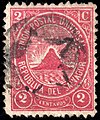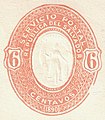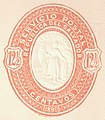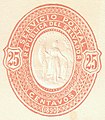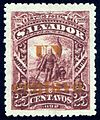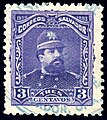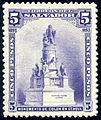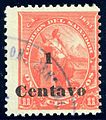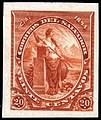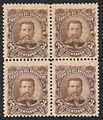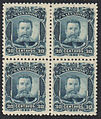Stamps of El Salvador 1867-1900
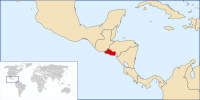

Definitive stamps[edit]
17 January 1867 and April 1873[edit]
Allegorical representation of the coat of arms existing at the time, depicting the Izalco volcano. Currency in reales, without watermark, perforated 12.
The stamps were made by the American Bank Note Co. of New York. Printed in September 1866, and officially issued on January 17, 1867. There are two printings, one in September 1866, and another in April 1873. The printings can be distinguished by the different color shades, and by the heavy yellow gum used on the first printing, which differs from the thin white gum used for the latter.
The set consists of four values: ½ Real (blue), 1 Real (red), 2 Reales (green) and 4 Reales (bistre), issued in sheets of 100. They feature an active volcano with 11 stars making a semi-circle above the volcano; each star represents Salvadoran provinces in those years: San Salvador, La Libertad, Sonsonate, Santa Ana, La Paz, Cuscatlán, Usulután, San Vicente, San Miguel, La Union, and Chalatenango.
-
First issued set (№ 1-4)
1874 Contrasello[edit]
The Government of El Salvador decided to discontinue the issues of 1867, and handstamp its stock with a black control mark that had the national coat of arms in the center, surrounded by the legend 'Contrasello - 1874' and a circle. The issue was probably counterstamped because a significant quantity of stamps was stolen from the San Salvador post office.
Three types of handstamps are known.
-
Contrasello handstamps, type I-III
-
Contrasello overprinted set, type III unused (№ 5-8)
1879[edit]
Celebrating the Salvadoran UPU affiliation. Currency in centavos de pesos instead of reales. Stamps were printed by Rufino Flamenco in El Salvador. Printed in panes of 25, number of printings per value:
- 1c: 8 printings,
- 2c: 2 printings,
- 5c: 2 printings,
- 10c: 1 printing,
- 20c: 1 printing.
-
2c I, type 1 unused. Plate error broken 'I' (№ 14)
-
2c II, type 3 unused (№ 14)
-
2c II, type 3 used (№ 14)
-
2c II, type 4 used (№ 14)
-
2c II, type 5 used (№ 14)
-
2c II, type 5 used (№ 14)
-
2c II, type 5 used (№ 14)
-
20c unused (№ 19)
-
20c used (№ 19)
-
20c used (№ 19)
-
20c used (№ 19)
-
20c used (№ 19)
-
20c used, top right plate error broken frame. (№ 19)
1883 Telegraph Stamps[edit]
1879 stamps handstamped 'CONTRASELLO' and coat of arms in black or purple. The "Contrasello" overprint of this issue was created by decree of December 5th 1882.
-
1c, overprint black
-
1c, overprint purple. Eighth printing: light green and inverted "V" for "A" in "REPUBLICA" on position 12.
-
2c, overprint black
-
2c, overprint purple
-
5c, overprint purple
1890[edit]
The issues of 1890 - 1899 were printed by the Hamilton Bank Note Engraving and Printing Company in New York. To the order of N.F. Seebeck, who held a contract for stamps with the government of El Salvador. Of each issue several essays were produced. Reprints of some of the adopted colors were made too, Seebeck had the contractual right.
Allegorical figure of El Salvador. The first stamps and postal stationery manufactured by the Hamilton Bank Note Engraving and Printing Company.
Postal stationery[edit]
Dies engraved by Rudolph Philipp Laubenheimer.
-
Wrapper imprinted stamps
-
3c wrapper
-
6c wrapper
-
12.5c wrapper
-
25c wrapper
-
Envelope imprinted stamps
Essays[edit]
-
5c green, block of four
-
20c green
-
1p brick red
1891[edit]
Volcano and train.
Essays[edit]
-
2c brown, block of six
-
3c brown, pair
-
5c green, block of four
-
10c green, block of four
-
11c violet, block of six, adopted color
-
11c brown, pair
-
20c brown
-
20c red, pair
-
20c yellow, block of six
-
20c dark brown
-
50c red, block of six
-
1p blue, block of four
1892[edit]
400th anniversary of the discovery of America by Columbus, the landing of Columbus.
Surcharges[edit]
Un centavo surcharges.
-
1c on 5c (№ 70a, 72)
-
1c on 20c used (№ 73)
-
1c on 25c (№ 74)
Essays[edit]
-
2c dark brown
-
10c vermillion, adopted color
-
10c blue
-
11c orange pair
-
20c red
-
25c orange
-
50c yellow, adopted color
-
50c blue pair
-
1p green pair
1893[edit]
President Carlos Ezeta. 2-10 peso depicting various scenes related to the 400th anniversary of the discovery of America by Columbus. The Scott catalog notes that the 2-peso stamp is known on cover but that the 5-peso and 10-peso stamps are not known to have been used as postage.
-
3c used (№ 78)
-
2p unused, founding of the city of Isabela (№ 86)
-
5p unused, Columbus Statue in Genoa (№ 87)
-
10p unused, departure from Palos (№ 88)
Essays[edit]
-
2c orange brown pair
-
5c maroon
-
50c red orange, adopted color
1894[edit]
Allegory of liberty. 2-10 pesos depicting various scenes related to the 400th anniversary of the discovery of America by Columbus.
-
2p-10p used (№ 101-103)
-
1c surcharge used (№ 104)
Essays[edit]
-
1c light brown
-
3c brown block of four
-
5c blue
-
20c orange brown
1895 First Issue[edit]
By January 1, 1895 a new issue of 12 denominations was delivered. The stamp vignette shows General Antonio Ezeta, brother of President Carlos Ezeta. After the stamps had been printed, the president was unseated by a revolution headed by Rafael Antonio Gutiérrez. The new authorities refused to accept the stamps picturing the brother of the deposed president. As a solution, it was ordered that the stamps be printed with the national coat of arms to obliterate the portrait.
Essays[edit]
-
1c essay olive brown
-
1c essay pair violet
-
2c essay pair brown
-
2c essay pair grey
-
3c essay pair blue
-
3c essay pair dark brown
-
5c essay pair blue
-
5c essay pair orange brown
-
5c essay pair orange red
-
12c essay pair green
-
15c essay pair yellow brown
-
15c essay pair red
-
20c essay pair green
-
20c essay pair yellow
-
30c essay pair dark blue
-
50c essay pair lake
-
50c essay pair orange red
-
50c essay pair yellow
-
1p essay pair brown
-
1p essay pair red brown
Reprints[edit]
-
3c reprint
-
10c reprint
-
30c reprint
1895 Second Issue[edit]
A second series was issued in 1895 picturing the national coat of arms within different frames. Reprints are known of all denominations of this issue, printed on paper thicker than the originals.
Essays[edit]
-
1c orange
-
1c green
-
2c yellow brown pair
-
5c blue pair
-
5c green pair
-
5c orange
-
10c blue pair
-
12c claret pair
-
30c green pair
-
50c brown pair




